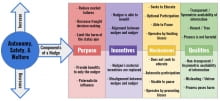Author: Brian Hengesbaugh

A nudge is an intervention with the goal of changing behavior by modifying one or more factors that influence how a decision is made, while still maintaining the existing range of options and the material incentive structure for the decision maker (Thaler & Sunstein, 2008). A notification from an app on your phone, the arrangement of products in a store, the presence of a default option, and the communication of the popularity of a decision are all nudges.
Nudges are functionally similar to many forms of interventions and policies (e.g., laws, regulations, education, and fines) because they all produce, or at least seek to produce, changes in behavior. The ethical examination of nudges is distinctly different from these other forms of behavioral influence, and particularly layered, because of the manner in which the nudger (i.e., entity implementing the intervention or choice architect) exerts influence over the nudgee (i.e., individual whose behavior is being changed by the intervention) (Hausman & Welch, 2010). The key differentiating factor is transparency (Thaler & Sunstein, 2008). Nudges often modify the nonconscious elements of decision making, and can therefore operate in a way that is unseen to the people being nudged (Sleringer and Powys, 2011). This lack of transparency means that it can be difficult for nudges to be contested. As a result, nudges are prone to intentional abuse and susceptible to the unintentional incompetence of the entities performing the nudge (Hausman & Welch, 2010; Thaler & Sunstein, 2008).
Governments, advertising firms, social media platforms, and employers are just some of the agents throughout our society using nudges to exert influence over others. It is essential to create a foundation of ethical understanding of nudges in order to be able to produce “rules of engagement” for choice architects that limit abuses of power, reduce errors, and ensure that the implementation of nudges is in the service of public interest (Thaler & Sunstein, 2008). The above image presents a framework that can be used to help evaluate whether a nudge is ethical. Does the nudge promote the autonomy, safety, or welfare of the nudgee? Are the purpose, incentives, mechanisms, and qualities aligned in their promotion of autonomy, safety, and welfare of the nudgee?
Note: Special thanks to Dr. Jason Borenstein for his feedback on this frameworkFurther Reading:
Hausman, D. M. and Welch, B. (2010), Debate: To Nudge or Not to Nudge. Journal of Political Philosophy, 18: 123-136.
Selinger, Evan and Whyte, Kyle Powys, Is There a Right Way to Nudge? The Practice and Ethics of Choice Architecture (July 10, 2011). Sociology Compass, Vol. 5, No. 10, pp. 923-935.
Thaler, R. & Sunstein, C. (2008) Nudge: Improving decisions about health, wealth, and happiness. New Haven: Yale University Press.










